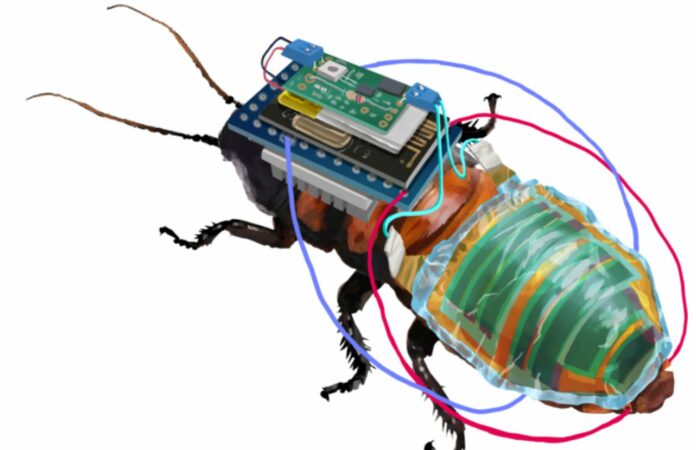An international team led by RIKEN Cluster for Pioneering Research (CPR) has developed a technology for building remote-controlled cyborg cockroaches, complete with a tiny wireless control module powered by a rechargeable battery hooked to a solar cell. Ultrathin electronics and flexible materials let insects move freely despite mechanical gadgets. These findings, published today in the scientific journal npj Flexible Electronics, will help make the use of cyborg insects a practical reality.
Researchers have been trying to make cyborg insects, which are part insects and part machines so that they can help check out dangerous areas or keep an eye on the environment. The ability to control cyborg insects remotely for extended periods of time is necessary for their use to be viable, though. This necessitates cordless, rechargeable battery-powered control of their leg segments. Maintaining a fully charged battery is essential; nobody wants a team of out-of-control cyborg cockroaches running around. Although docking stations for charging the battery could be constructed, the requirement to return and recharge might interfere with missions that must be completed on schedule. In order to ensure that the battery is always charged, the ideal solution is to incorporate an onboard solar cell.
This is all easier said than done. To get these devices to work on a cockroach, which has a small surface area, the research team had to make a special backpack, ultrathin organic solar cell modules, and an adhesion system that keeps the machines attached for long periods of time but still lets the cockroach move normally.
The team conducted research using 6 cm long Madagascar cockroaches under the direction of Kenjiro Fukuda, RIKEN CPR. They used a specially created backpack that was based on the body of a model cockroach to attach the wireless leg-control module and lithium polymer battery to the top of the bug on the thorax. The hard electronic equipment was able to be securely attached to the thorax for more than a month thanks to the elastic polymer backpack, which was 3D printed and flawlessly fitted to the curved surface of the cockroach.
The dorsal side of the abdomen was mounted with the 0.004 mm thick organic solar cell module. Fukuda says that the power output of the body-mounted ultrathin organic solar cell module, which is 17.2 mW, is more than 50 times greater than the power output of the most advanced energy harvesting devices currently being used on living insects.
Movement freedom was made possible by the organic solar cell’s ultrathin and flexibility, as well as how it was attached to the insect. Scientists observed natural cockroach behavior and concluded that the abdomen twists and the exoskeleton overlaps in certain ways. They interspersed adhesive and non-adhesive regions onto the films to accommodate this, allowing the films to stretch while maintaining their bond. Cockroaches took twice as long to cover the same distance when tested with thicker solar cell films or when the films were uniformly attached, and they had trouble righting themselves when they fell on their backs.
After these parts and cables that activate the cockroaches’ leg segments were implanted, the resulting cyborgs were put to the test. After 30 minutes of charging under fake sunshine, the battery was ready to be used to control the direction the animals faced using the wireless remote.
“Considering the deformation of the thorax and abdomen during basic locomotion, a hybrid electronic system of rigid and flexible elements in the thorax and ultrasoft devices in the abdomen appears to be an effective design for cyborg cockroaches,” adds Fukuda. “Moreover, since abdominal deformation is not unique to cockroaches, our strategy can be adapted to other insects like beetles, or perhaps even flying insects like cicadas in the future.”
Image Credit: Getty
You were reading: The Race To Create Most Advanced Cyborg Insects Just Reached New Heights
